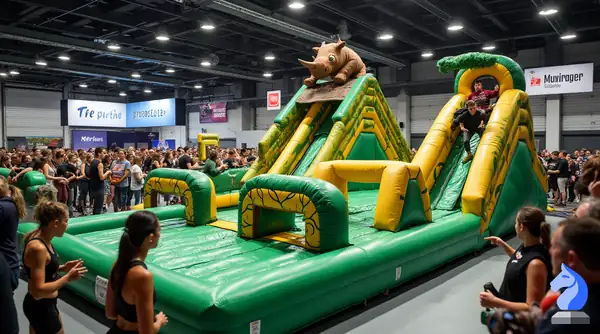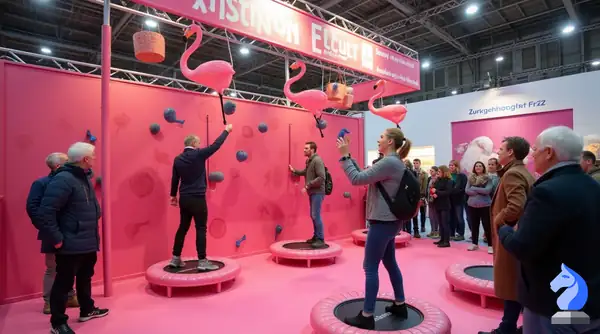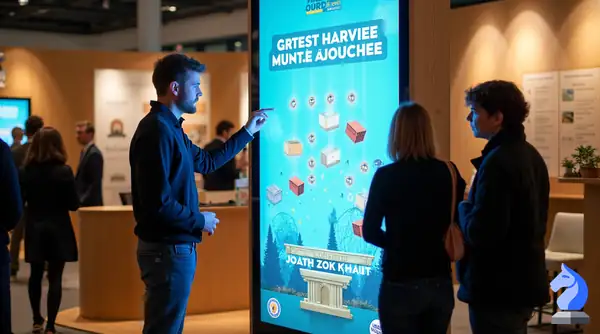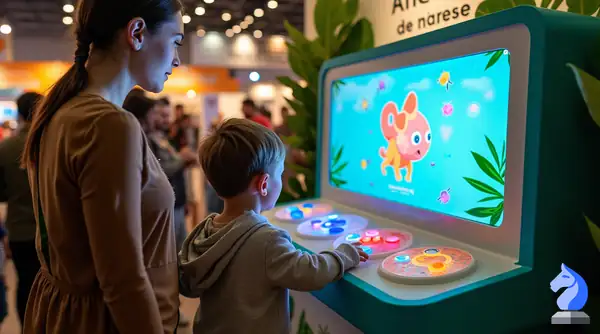
In Sweden, where balance and harmony—lagom—are deeply valued, exhibitions are not just about information; they’re about experience. Adding interactive games to your booth is a modern way to increase footfall, spark curiosity, and leave a lasting impression.
In this article, we’ll introduce 15 exhibition game ideas across four engaging categories for ZoorfExpo. Whether your goal is brand awareness or meaningful interaction, these ideas are designed to resonate with Swedish audiences who appreciate thoughtful, playful encounters. Our team is here to support your implementation.
When people visit an exhibition, they often appreciate light physical activity—something fun, energizing, and not too complicated. In a society that values simplicity and movement, physical games can be a perfect way to break the ice and attract attention. These games don’t require deep thinking, but they do get people involved—ideal for creating a vibrant booth. For example, take a look at this activation we ran:
Imagine a sturdy, eye-catching inflatable or metal-framed course with rhino-themed décor, where attendees dash through tunnels, dodge swinging obstacles, and climb ramps. The look and feel should be robust and intimidating—ensuring that fair-goers see it as a professional attraction, not a DIY project. The sheer excitement of racing through a safari-style layout generates a crowd as participants compete to finish in under two minutes.

In this game, players stand on a small springboard or mini-trampoline—painted with bright flamingo pink—and toss rubber fish into high-mounted buckets. The buckets, flamboyantly designed like flamingo beaks, are positioned at varying heights and angles. Quick reflexes and a good sense of timing are key. The attractive pink structure, plus the comedic spectacle of participants bouncing around, ensures nobody thinks it’s just an ordinary backyard game.

Create a tall vertical frame or climbing wall decked out with molded “gorilla handholds.” Competitors strap in with professional harnesses and attempt to climb as high as possible within two minutes. The imposing design—complete with giant gorilla silhouettes—makes it clear this is a specialized setup. The physical challenge of scaling the wall draws crowds and gives an adrenaline-pumping experience.

These games work well when placed on a digital stand in your booth and can also be extended to your website, social media, or internal communications. In Sweden, digital interaction is expected to be seamless, accessible, and informative. Knowledge-based games are great for educating visitors in a fun way—and they’re easy to adapt for two-player competition. Here’s a sample from one of our past projects:
This interactive station uses the template of falling items—some correct, some incorrect—related to caring for endangered species.
A successful run means no harmful crate crosses the sanctuary gate and no correct crate gets destroyed. The entire session runs under two minutes, making it a high-energy learning tool.

If your goal is to boost engagement while maintaining a challenge, this format is ideal. Visitors try to beat a high score, track their own progress, and climb the leaderboard. This game style aligns well with the Swedish love of fair competition and personal improvement. A transparent leaderboard motivates people to participate again and again. Check out this example:
All five can be tweaked for a maximum two-minute session.
Players control a little lion cub dashing across the savannah, leaping over rocks and logs, collecting “pride points.” Each obstacle requires a single tap or click at just the right time. Mistime a jump and the cub stumbles—game over. Quick, intuitive, and fosters a fun lion-themed brand presence.

Place a digital chameleon at the bottom of the screen. Bugs of various colors zip by overhead. Players must rapidly tap the correct color button so the chameleon’s tongue snags only the matching-colored insect. If the chameleon eats a mismatched bug, you lose. Fun, bright visuals highlight the chameleon’s color-changing skill and the importance of balanced feeding.

Picture a playful panda on a bamboo slide. Players swipe left or right to dodge obstacles like rolling bamboo logs. Each run is less than a minute. The concept is easy to learn and yields plenty of laughter, especially if the panda occasionally tumbles in a comedic animation for a “game over.”

The character is a busy zookeeper running through the zoo grounds, collecting feed bags while leaping over or sliding under small gates. An energy meter depletes if you collide with obstacles or miss too many feed bags. Sessions last around a minute, capturing the energy of a real zoo on the move.

The screen is a vertical corridor in the sky. Players control an eagle gliding through cloud rings. Tap to move up or let go to move down, trying to pass through each ring perfectly. It’s reminiscent of a classic “flap or fall” style game but re-skinned with regal eagles—excellent for highlighting majestic bird conservation themes.

This format works best when your brand is already well-known, and you want to create excitement. If your product or service is unfamiliar, we don’t recommend starting with this type. Swedes often value fairness and transparency, so be sure your chance-based games feel lighthearted and fun—never gimmicky. Here’s how we’ve used it in the past:



Exhibition games are more than just fun—they’re strategic tools to engage visitors, communicate your message, and differentiate your booth. In a culture that values subtlety and meaningful interaction, gamification offers a respectful and impactful way to connect.
We invite you to explore your options by filling out our Exhibition Game Design Form for ZoorfExpo. You’ll receive a free one-hour consultation and get to see some of our latest creations. Let’s design something unforgettable together.will remember long after the fair is over!